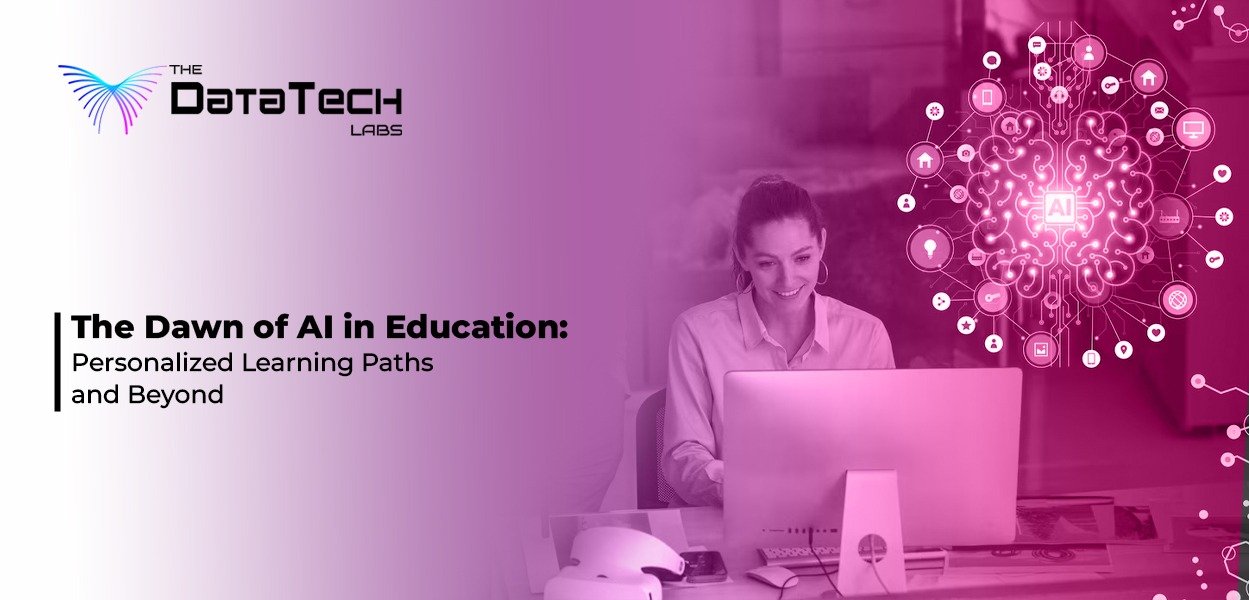
The Dawn of AI in Education: Personalized Learning Paths and Beyond
Education is a foundational pillar of society. It shapes our understanding of the world, equips us with skills, and helps us realize our potential. Today, we stand on the cusp of a new era in education, driven by the adaptability and competitive edge provided by Artificial Intelligence (AI).
AI’s breakthroughs are reshaping the educational landscape by tailoring the learning experience to individual needs. It’s a game-changer, transforming the one-size-fits-all education model into a dynamic, adaptable learning journey tailored to each student.
How does AI accomplish this? At its core, AI uses algorithms that learn from data. In education, these algorithms can analyze a student’s interaction with learning materials, identify strengths and weaknesses, and adjust the content and pacing to optimize the learning process.
Let’s take a deeper look at how AI personalizes education.
Step 1: Data Collection
The process begins with data collection. AI tools collect data on a student’s interaction with the learning platform. This can include which topics the student interacts with, how much time they spend on each topic, the number of attempts they make on a question, and their success rate.
Step 2: Data Analysis
AI then uses machine learning algorithms to analyze this data. These algorithms identify patterns in the student’s learning behavior, such as which topics they find challenging, what mistakes they commonly make, and how quickly they learn.
Step 3: Personalization
Based on this analysis, the AI adapts the learning path for the student. For instance, if a student struggles with a particular topic, the AI will provide more resources and practice questions on that topic. It can also adjust the difficulty level of questions to match the student’s proficiency.
Step 4: Feedback
AI can provide real-time feedback to students, pointing out mistakes and explaining the correct solutions. This immediate feedback helps students correct misconceptions and improve their understanding.
Step 5: Progress Tracking
AI tools can track a student’s progress over time, offering insights into how their understanding and skills are developing. This can be useful for both students and teachers, helping them identify areas for further study.
Step 6: Adaptation
One of the key advantages of AI is its ability to continually adapt. As the student learns and grows, the AI adjusts the learning path to keep it challenging and engaging. This means that the learning experience is always tailored to the student’s current needs.
Step 7: Empowering Educators
AI tools can provide teachers with data-driven insights into their students’ learning. This can help teachers identify students who might need extra support, understand what concepts the class as a whole finds difficult, and track the progress of the class over time.
In this way, AI does not replace teachers but empowers them. It handles the task of personalizing the learning content and provides teachers with valuable insights, freeing them to focus on facilitating learning and supporting their students.
In summary, AI is transforming education by making it a personalized, adaptable, data-driven process. This has the potential to make learning more effective and engaging, and ultimately lead to better learning outcomes for students.
Let’s delve into three concrete examples from the USA, India, and the Middle East and Africa (MEA) region that showcase AI’s adaptability and competitive edge in education.
In the USA, an edtech company called “Carnegie Learning” developed an AI-powered tool called “MATHia”. This tool is designed to act like a personal tutor, guiding students through math problems and adjusting the difficulty level based on student performance. It adapts to each student’s unique learning style, offering a personalized path through the curriculum.
In India, an innovative platform called “Embibe” is using AI to personalize education at scale. Embibe’s AI algorithms analyze students’ answers to questions, identifying not just what they got wrong, but why. It detects knowledge gaps and misconceptions and offers targeted feedback to help students improve. This level of personalization is highly adaptable, as it can cater to diverse student populations with varying learning needs.
In the MEA region, Alef Education, a UAE-based edtech company, is leveraging AI to create a dynamic learning environment. Their platform uses AI to understand a student’s learning behavior, adapting content, and delivery method in real time. This platform is providing a competitive edge to schools in the UAE by enhancing student engagement and learning outcomes.
In these examples, AI’s adaptability shines through its ability to tailor learning experiences to individual needs, even within large student populations. This adaptability allows AI to reach learners where they are, accommodating different learning styles, and offering customized pathways to mastery.
AI’s competitive edge lies in its potential to enhance learning outcomes by delivering personalized education. It transforms the role of teachers, freeing them from administrative tasks and providing them with data-driven insights into their students’ learning. This allows teachers to focus on what they do best: inspire and facilitate learning.
However, as we continue to integrate AI into education, we must be mindful of potential challenges. Ensuring data privacy, mitigating algorithmic bias, and maintaining the human touch in education are essential considerations as we navigate this new era.
In conclusion, the dawn of AI in education promises a future where learning is not a one-size-fits-all process, but a personalized journey that adapts to each learner’s unique needs and pace. The adaptability and competitive edge offered by AI can revolutionize education, making it more engaging, effective, and equitable. As we embrace this future, we must ensure that AI serves to enhance, not replace, the invaluable human elements of teaching and learning. This is the dawn of a new era in education, and the potential is as vast as our imagination.
Leave a Reply